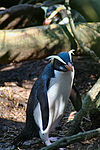Crested penguins
| Crested penguins | ||||||||||||
|---|---|---|---|---|---|---|---|---|---|---|---|---|

Crested penguins ( Eudyptes chrysolophus ) |
||||||||||||
| Systematics | ||||||||||||
|
||||||||||||
| Scientific name | ||||||||||||
| Eudyptes | ||||||||||||
| Vieillot , 1817 |

The crested penguins ( Eudyptes ) are a genus of birds from the penguin family (Spheniscidae). The crested penguins are the largest penguin genus with seven species. In older literature, the number of species is still regularly given as only six species, since the taxonomic classification of the northern rockhopper penguin has only been generally recognized since 2006.
Crested penguins make up around 45 percent of the world's penguin population and are estimated to have over 28 million breeding pairs. The genus includes the golden crested penguin, one of the numerically most frequent penguin species, and the thick-billed penguin, one of the most endangered species among penguins. Its closest relative among the recent penguin species is the yellow-eyed penguin , which is one of the three rarest penguin species.
features
Crested penguins typically have dark heads. The only exception is the crested penguin , whose face is white and only has a dark skull. Common to all species are yellow decorative feathers on the face. As with the rockhopper penguin, these can be several centimeters long. In contrast, the feathers of the crowned penguin are significantly shortened, but can be set up by him.
Way of life
Crested penguins share a number of common behavioral traits. In principle, they do not reach sexual maturity before they have reached the age of five to six years. Both the crested penguin and the golden crested penguin do not breed for the first time until they are seven to nine years old.
Their colonies only exist during the breeding season. In all species there is an obligatory breeding reduction, which occurs in all penguin species whose clutch consists of two eggs, only in the crested penguins: Although two eggs are always laid, usually only one young is raised, because of an unfavorable distribution of food, in the end none of the kittens is getting enough food to avoid. Usually only one young bird hatches. Very often the first egg is removed by one of the parent birds - usually the female - or is lost during the brood separation. When both young birds hatch, it is usually the chick of the first egg that starves to death within ten days because it is not being fed by the parent birds. There is only one documented case so far in which Snare Island penguins raised both young birds.
species
The following species belong to the crested penguins:
Thick-billed penguin,
Eudyptes pachyrhynchusRockhopper penguin
Eudyptes chrysocomeCrested penguin
Eudyptes chrysolophusCrested penguin,
Eudyptes schlegeliNorthern rockhopper penguin
Eudyptes moseleyi , formerly classified as a subspecies of rockhopper penguinSnare
island penguin Eudyptes robustusCrowned penguin ( Eudyptes sclateri )
supporting documents
literature
- Hadoram Shirihai: A Complete Guide to Antarctic Wildlife - The Birds and Marine Mammals of the Antarctic Continent and Southern Ocean , Alula Press, Degerby 2002, ISBN 951-98947-0-5
- Tony D. Williams: The Penguins . Oxford University Press, Oxford 1995, ISBN 0-19854-667-X






